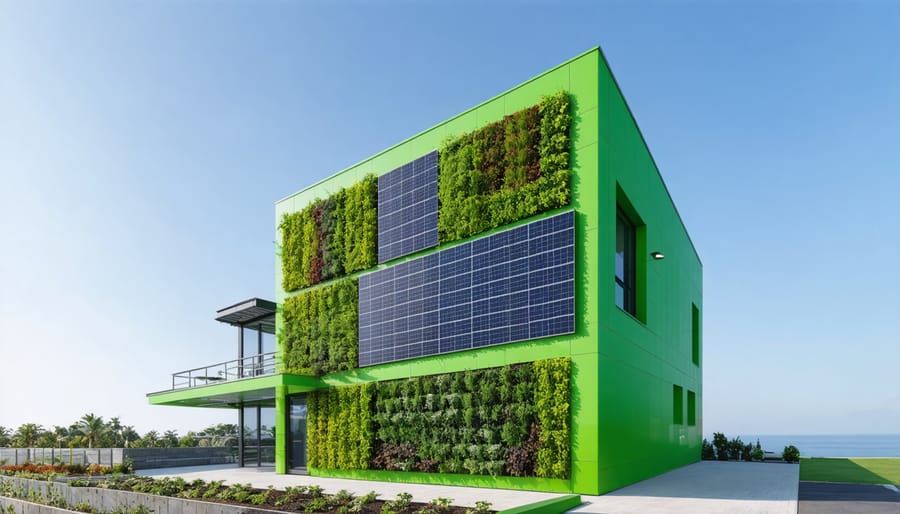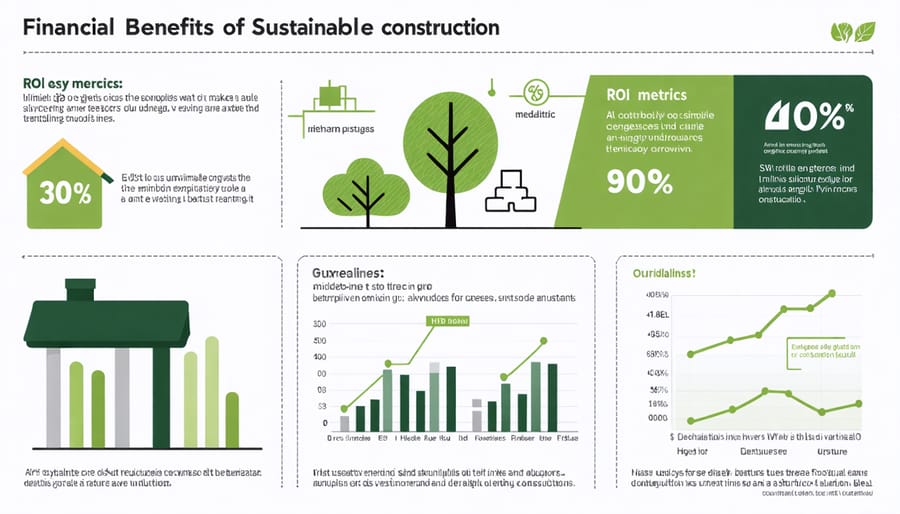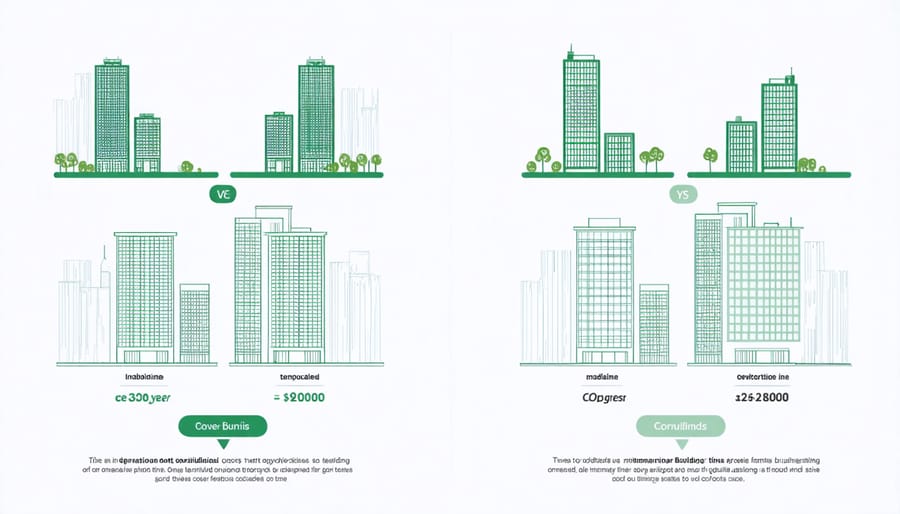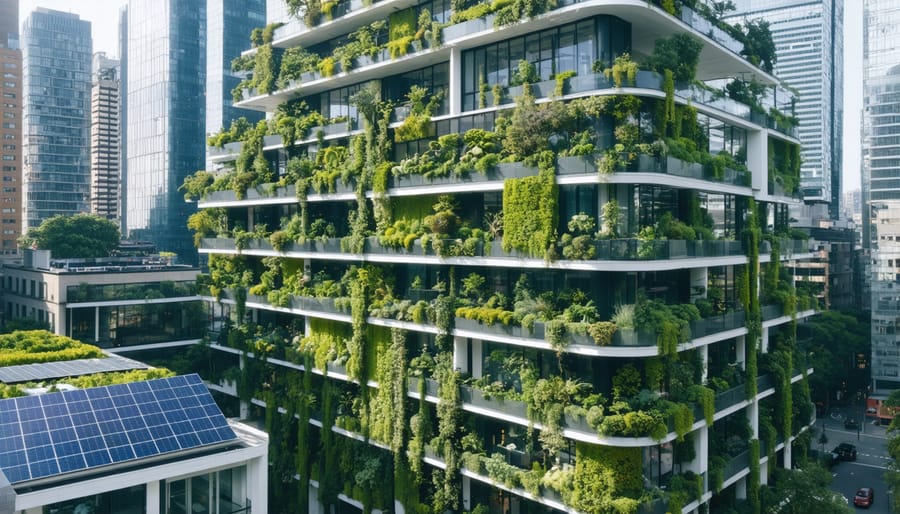Sustainable construction has emerged as a transformative force in today’s building industry, delivering unprecedented returns on investment while addressing urgent environmental challenges. Leading construction firms implementing sustainable building practices consistently report 15-20% lower operating costs, 7-8% higher building values, and significantly enhanced project marketability. Beyond immediate financial gains, sustainable construction projects demonstrate superior resilience to market fluctuations, reduced regulatory compliance risks, and improved occupant wellness metrics – factors increasingly crucial for institutional investors and corporate clients.
Recent data from the World Green Building Council reveals that green buildings command premium lease rates while reducing energy consumption by up to 50% compared to conventional structures. This dual advantage of increased revenue potential and decreased operational expenses creates a compelling business case for sustainability in construction, particularly as global environmental regulations tighten and ESG considerations become paramount in investment decisions.
For construction professionals and project stakeholders, understanding these benefits isn’t just about environmental stewardship – it’s about securing competitive advantage in an evolving market where sustainability increasingly defines project success and long-term asset value.
Financial Returns of Sustainable Building Practices

Operational Cost Reduction
Implementing sustainable construction practices leads to significant operational cost reductions through multiple channels. Studies show that green buildings can reduce energy consumption by 25-35% through various energy cost reduction strategies, including high-performance building envelopes, smart HVAC systems, and efficient lighting solutions.
Water efficiency measures in sustainable buildings typically result in 30-50% lower water consumption compared to conventional structures. This is achieved through the installation of low-flow fixtures, rainwater harvesting systems, and greywater recycling infrastructure. For commercial buildings, these water conservation methods can translate to annual savings of $0.50-$1.50 per square foot.
Maintenance costs are substantially reduced in sustainable buildings due to the use of durable, high-quality materials and smart monitoring systems. Green buildings report 13% lower maintenance costs on average, with some facilities experiencing savings of up to 20%. These reductions stem from longer material lifecycles, fewer replacement requirements, and predictive maintenance capabilities enabled by building management systems.
The combination of these efficiency measures creates a compelling financial case for sustainable construction. According to the U.S. Green Building Council, LEED-certified buildings report almost 20% lower maintenance costs than typical commercial buildings, with a significant portion of these savings realized within the first year of operation. When factoring in rising energy costs and increasing water scarcity, these operational savings are expected to grow even further in the coming years.
Enhanced Property Value
Sustainable construction significantly enhances property value through multiple pathways, creating a compelling business case for green building investments. Recent market analyses indicate that certified sustainable buildings command premium prices, typically 7-11% higher than conventional properties, with rental rates averaging 6-8% above market standards.
This value proposition stems from several key factors. Operating costs in sustainable buildings are substantially lower, with energy-efficient systems reducing utility expenses by 25-35% on average. The implementation of smart building technologies and sustainable materials also results in reduced maintenance requirements and extended building lifecycles, contributing to higher net operating income.
Market demand for sustainable properties continues to grow, driven by environmentally conscious tenants and stringent environmental regulations. Corporate tenants increasingly prioritize green buildings to meet their ESG commitments and enhance their brand image, leading to higher occupancy rates and stronger tenant retention.
Studies by major real estate firms demonstrate that sustainable buildings maintain their value better during market downturns and experience faster appreciation rates. The resilience features inherent in sustainable construction, such as advanced water management systems and climate-adaptive designs, protect against future climate-related risks and regulatory changes.
Furthermore, sustainable properties often qualify for tax incentives, zoning bonuses, and expedited permits, adding additional layers of value to the initial investment. This combination of reduced operating costs, increased market demand, and regulatory advantages creates a compelling long-term value proposition for sustainable construction projects.

Green Building Financing Options
Green Mortgages and Loans
Financial institutions increasingly recognize sustainable construction as a lower-risk investment, leading to the development of specialized green mortgage and loan products. These financial instruments offer preferential terms for projects meeting specific environmental criteria, including enhanced energy efficiency, renewable energy integration, and sustainable material usage.
Green mortgages typically provide benefits such as reduced interest rates (usually 0.25% to 0.5% lower than standard rates), increased loan-to-value ratios, and extended repayment periods. For example, major lenders now offer loans up to 85% of the property value for buildings achieving LEED Gold certification or equivalent standards, compared to the typical 75% for conventional properties.
Construction companies can also access specialized green construction loans that finance sustainable building practices from groundbreaking to completion. These products often feature reduced documentation requirements, faster approval processes, and lower fees when projects meet predetermined sustainability benchmarks.
Additional financial incentives may include:
– Reduced mortgage insurance premiums
– Higher debt-to-income ratio allowances
– Reimbursement of certification costs
– Cash-back rewards for achieving energy performance targets
To qualify, projects typically must demonstrate compliance with recognized green building standards and achieve specific energy efficiency targets. Many lenders work with third-party verifiers to assess eligibility and monitor ongoing performance, ensuring the integrity of these financial products while supporting the transition to sustainable construction practices.
Government Incentives
Governments worldwide are increasingly offering substantial financial incentives to promote sustainable construction practices. In the United States, the Federal Tax Credit for Commercial Buildings (179D) provides up to $1.88 per square foot for projects meeting specific energy efficiency criteria. Additionally, the Investment Tax Credit (ITC) offers a 26% tax credit for solar energy systems installed during construction.
Many state and local governments supplement federal incentives with their own programs. California’s Title 24 compliance rewards builders with expedited permits and reduced fees for exceeding energy efficiency standards. New York’s Green Building Tax Credit provides up to $2 million in tax incentives for commercial projects achieving LEED certification.
Grant opportunities are also abundant, with the Department of Energy’s Building Technologies Office offering competitive grants for innovative sustainable construction technologies. The Environmental Protection Agency’s Clean Water State Revolving Fund provides low-interest loans for green infrastructure projects.
Local utility companies often partner with governments to offer rebates for energy-efficient building systems. These can include up to 50% cost reduction on LED lighting systems, HVAC upgrades, and smart building technologies. Some municipalities provide density bonuses, allowing developers to increase their building’s floor area ratio when incorporating sustainable features.
To maximize these benefits, construction professionals should engage with sustainability consultants early in the project planning phase and maintain detailed documentation of green building features and associated costs.
ESG Investment Opportunities
ESG-focused investments in sustainable construction have seen remarkable growth, with global sustainable investment reaching $35.3 trillion in 2020, representing a significant opportunity for construction firms embracing green building practices. Investment firms and institutional investors increasingly view sustainable construction projects as lower-risk investments that align with their ESG mandates and offer competitive returns.
Companies demonstrating strong environmental performance through sustainable construction practices typically attract more favorable financing terms and wider access to capital markets. Major financial institutions now offer green building loans, sustainability-linked bonds, and specialized financing packages with preferential rates for projects meeting specific ESG criteria.
The social aspect of ESG in construction encompasses worker safety, community impact, and stakeholder engagement. Projects incorporating these elements often receive enhanced community support and face fewer regulatory hurdles, making them more attractive to investors seeking socially responsible opportunities.
From a governance perspective, sustainable construction projects demonstrate commitment to transparency, regulatory compliance, and risk management. This improved governance structure appeals to institutional investors and can lead to higher valuations and better access to capital markets.
Real-world evidence supports this trend, with sustainable buildings commanding premium rental rates and higher occupancy levels. According to recent market analysis, green-certified buildings typically achieve 6-10% higher rental premiums and 15-20% lower operating costs, making them particularly attractive for long-term investment portfolios.
Risk Mitigation Through Sustainability
Regulatory Compliance
Staying ahead of environmental regulations is becoming increasingly critical for construction companies worldwide. By adopting sustainable construction practices today, organizations can effectively future-proof their operations against evolving regulatory requirements. Recent studies indicate that companies implementing proactive sustainability measures spend 30% less on compliance-related adjustments compared to those taking a reactive approach.
The global push toward reducing building emissions has led to stricter building codes and environmental standards. Forward-thinking construction firms that exceed current requirements often find themselves well-positioned when new regulations come into effect, avoiding costly retrofits and compliance penalties.
Consider the European Union’s Energy Performance of Buildings Directive (EPBD), which continues to set increasingly stringent standards. Companies that invested in sustainable practices before implementation reported smoother transitions and maintained competitive advantages. Similarly, in North America, jurisdictions are rapidly adopting more rigorous green building codes, making early adoption of sustainable practices a strategic necessity.
Key benefits of regulatory compliance through sustainable construction include:
– Reduced risk of non-compliance penalties
– Lower costs for future regulatory adaptations
– Enhanced project approval processes
– Increased stakeholder confidence
– Better positioning for government contracts and incentives
By implementing sustainable practices now, construction companies can transform regulatory compliance from a challenge into a competitive advantage.
Market Resilience
Sustainable construction offers significant protection against market volatility, particularly in energy markets where prices can fluctuate dramatically. Buildings designed with energy efficiency at their core maintain consistent operational costs even when traditional energy prices spike. This resilience is particularly evident in structures incorporating renewable energy systems, which can reduce dependency on grid electricity by up to 70%.
Recent market analysis shows that sustainable buildings command premium rental rates and maintain higher occupancy levels compared to conventional properties. During economic downturns, green buildings typically experience smaller vacancies and shorter void periods, demonstrating their appeal to quality tenants who prioritize operational efficiency and corporate sustainability goals.
The adaptability of sustainable buildings also provides protection against changing market demands. Features such as flexible floor plans, modular designs, and upgradeable building systems allow properties to evolve with tenant needs without requiring extensive renovations. This adaptability extends the building’s functional lifespan and ensures continued market relevance.
Furthermore, sustainable construction methods often incorporate resilient design principles that protect against future regulatory changes. As environmental regulations become increasingly stringent, buildings that already exceed current standards are better positioned to maintain compliance without costly retrofits. This forward-thinking approach helps shield investors from unexpected compliance costs and maintains the asset’s long-term value proposition.
Case Study: ROI in Action
The Empire State Building’s sustainability retrofit project stands as a compelling example of successful ROI from sustainability initiatives. In 2009, the building’s owners invested $550 million in a comprehensive sustainability upgrade, which has yielded remarkable returns and valuable insights for the construction industry.
The project implemented multiple sustainable features, including high-performance window retrofits, upgraded building management systems, and enhanced insulation. These improvements resulted in a 40% reduction in energy consumption and annual energy cost savings of $4.4 million, surpassing initial projections by 15%.
The retrofit achieved payback within three years, significantly faster than the anticipated five-year timeline. Additionally, the building’s market value increased by $160 million, and tenant occupancy rates improved by 25%. The project demonstrated how sustainable construction can simultaneously address environmental concerns and deliver substantial financial returns.
Key success factors included:
– Comprehensive energy modeling before implementation
– Phased implementation to minimize disruption
– Integration of multiple systems for optimal performance
– Regular monitoring and adjustment of systems
– Engagement with tenants to maximize efficiency gains
This case study highlights how strategic sustainable construction investments can generate both immediate cost savings and long-term value appreciation. The project’s success has influenced numerous similar initiatives across the commercial construction sector, establishing a blueprint for profitable sustainable building retrofits.

The evidence is clear: sustainable construction delivers substantial benefits across environmental, financial, and social dimensions. By implementing green building practices, organizations can achieve significant cost savings through reduced energy consumption, lower maintenance expenses, and increased property values. The ROI potential is particularly compelling, with studies showing green buildings commanding premium rental rates and higher occupancy levels.
To successfully implement sustainable construction financing, organizations should begin by conducting thorough cost-benefit analyses and exploring available funding options, including green bonds, government incentives, and specialized lending programs. Establishing partnerships with financial institutions experienced in sustainable construction projects can provide access to competitive financing terms and valuable expertise.
Key action steps include:
– Developing a comprehensive sustainability strategy aligned with business objectives
– Securing appropriate certifications (LEED, BREEAM, etc.)
– Building relationships with green-focused financial institutions
– Documenting and tracking sustainability metrics
– Engaging stakeholders throughout the project lifecycle
By embracing sustainable construction practices and leveraging available financing mechanisms, organizations can position themselves for long-term success while contributing to environmental stewardship and social responsibility. The transition to sustainable construction is not just an environmental imperative—it’s a sound business decision that delivers measurable returns on investment.

